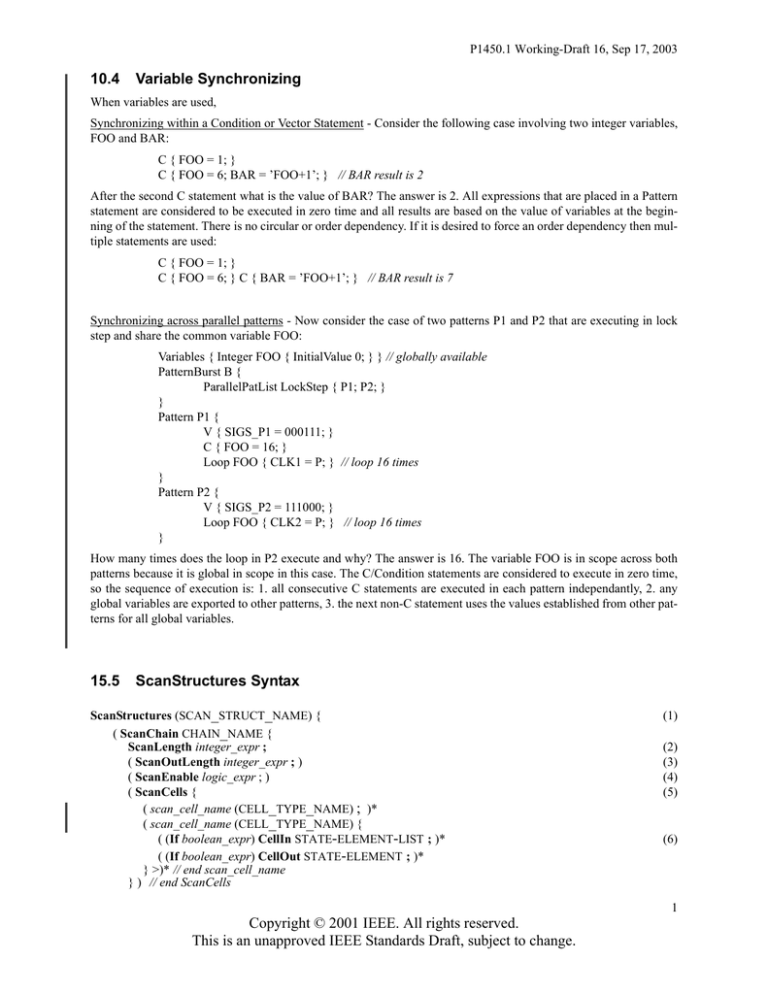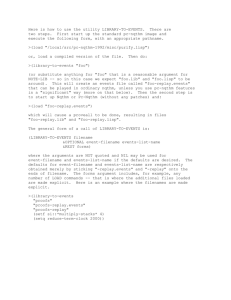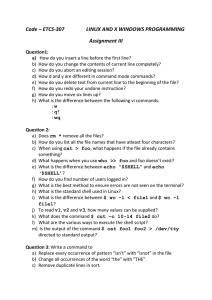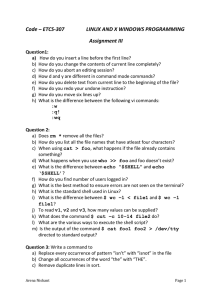
P1450.1 Working-Draft 16, Sep 17, 2003
10.4
Variable Synchronizing
When variables are used,
Synchronizing within a Condition or Vector Statement - Consider the following case involving two integer variables,
FOO and BAR:
C { FOO = 1; }
C { FOO = 6; BAR = ’FOO+1’; } // BAR result is 2
After the second C statement what is the value of BAR? The answer is 2. All expressions that are placed in a Pattern
statement are considered to be executed in zero time and all results are based on the value of variables at the beginning of the statement. There is no circular or order dependency. If it is desired to force an order dependency then multiple statements are used:
C { FOO = 1; }
C { FOO = 6; } C { BAR = ’FOO+1’; } // BAR result is 7
Synchronizing across parallel patterns - Now consider the case of two patterns P1 and P2 that are executing in lock
step and share the common variable FOO:
Variables { Integer FOO { InitialValue 0; } } // globally available
PatternBurst B {
ParallelPatList LockStep { P1; P2; }
}
Pattern P1 {
V { SIGS_P1 = 000111; }
C { FOO = 16; }
Loop FOO { CLK1 = P; } // loop 16 times
}
Pattern P2 {
V { SIGS_P2 = 111000; }
Loop FOO { CLK2 = P; } // loop 16 times
}
How many times does the loop in P2 execute and why? The answer is 16. The variable FOO is in scope across both
patterns because it is global in scope in this case. The C/Condition statements are considered to execute in zero time,
so the sequence of execution is: 1. all consecutive C statements are executed in each pattern independantly, 2. any
global variables are exported to other patterns, 3. the next non-C statement uses the values established from other patterns for all global variables.
15.5
ScanStructures Syntax
ScanStructures (SCAN_STRUCT_NAME) {
( ScanChain CHAIN_NAME {
ScanLength integer_expr ;
( ScanOutLength integer_expr ; )
( ScanEnable logic_expr ; )
( ScanCells {
( scan_cell_name (CELL_TYPE_NAME) ; )*
( scan_cell_name (CELL_TYPE_NAME) {
( (If boolean_expr) CellIn STATE-ELEMENT-LIST ; )*
( (If boolean_expr) CellOut STATE-ELEMENT ; )*
} >)* // end scan_cell_name
} ) // end ScanCells
(1)
(2)
(3)
(4)
(5)
(6)
1
Copyright © 2001 IEEE. All rights reserved.
This is an unapproved IEEE Standards Draft, subject to change.
P1450.1 Working-Draft 16, Sep 17, 2003
} )* // end ScanChain
( ScanChainGroups {
( GROUP_NAME { (GROUP_OR_CHAIN_NAME; )* } )*
}) // end ScanChainGroups
} // end ScanStructures
(7)
(5) ScanCells: This statement shall appear at most once in a ScanChain block. It shall contain either: a) a space
separated list of scan cell names as defined in IEEE Std. 1450-1999, or b) a brace delimited block containing a semicolon separated list of scan cell names. The new block form of this statement allows for additional attributes to be
attached to the scan cells to define complex scan cells. See “ScanStructures using complex scan cells” on page 92 for
examples of this construct.
CELL_TYPE_NAME - In the new brace delimited form, an optional cell type name may be defined. Once this
name has been established, all subsequent cells of the same type may then reference this name and be semi-colon
delimited. Cell type names shall be defined (i.e., brace statement) before used (i.e., semicolon statement). Cell type
names are in-scope for the ScanStructure block in which they are defined.
2
Copyright © 2001 IEEE. All rights reserved.
This is an unapproved IEEE Standards Draft, subject to change.




